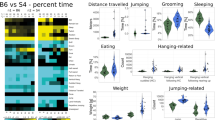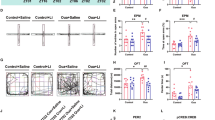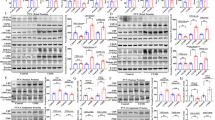Abstract
The molecular mechanism of action of the mood stabilizer lithium is assumed to involve changes in gene expression leading to neuronal adaptation. The transcription factor CREB (cAMP-responsive element binding protein) regulates the expression of many genes and has been implicated in important brain functions and the action of psychogenic agents. We here investigated the effect of lithium on cAMP-responsive element (CRE)/CREB-mediated gene transcription in the brain, using transgenic reporter mice that express the luciferase reporter gene under the control of four copies of the rat somatostatin gene promoter CRE. Chronic (21 days) but not acute (24 h) treatment with lithium (7.5 mmol/kg) significantly decreased CRE/CREB-directed gene expression in hippocampus, cortex, hypothalamus, and striatum to 60–70%, and likewise reduced CREB phosphorylation. As bipolar disorder is also considered as a stress-related disorder, the effect of lithium was determined in mice submitted to a paradigm for chronic psychosocial stress. As shown before, stress for 25 days significantly increased CRE/CREB-directed gene expression in several brain regions by 100–150%. Treatment of stressed mice with lithium decreased stress-induced CRE/CREB-directed gene expression to control levels in nearly all brain regions and likewise reduced CREB phosphorylation. Chronic lithium treatment induced β-catenin accumulation and decreased cAMP levels, indicating an inhibitory effect of lithium on glycogen synthase kinase 3 and the adenylate cyclase/protein kinase A signalling cascade, which are known to modulate CREB activity. We here for the first time show that lithium regulates CRE/CREB-directed gene transcription in vivo and suggest CREB as a putative mediator of the neuronal adaptation after chronic lithium treatment.
Similar content being viewed by others
Log in or create a free account to read this content
Gain free access to this article, as well as selected content from this journal and more on nature.com
or
References
Agranoff BW, Fisher SK (2001). Inositol, lithium, and the brain. Psychopharmacol Bull 35: 5–18.
Boer U, Alejel T, Beimesche S, Cierny I, Krause D, Knepel W et al (2007a). CRE/CREB-driven up-regulation of gene expression by chronic social stress in CRE-luciferase transgenic mice: reversal by antidepressant treatment. PLoS ONE 2: e431.
Boer U, Eglins J, Krause D, Schnell S, Schofl C, Knepel W (2007b). Enhancement by lithium of cAMP-induced CRE/CREB-directed gene transcription conferred by TORC to the CREB basic region leucine zipper domain. Biochem J 408: 69–77.
Bosetti F, Seemann R, Bell JM, Zahorchak R, Friedman E, Rapoport SI et al (2002). Analysis of gene expression with cDNA microarrays in rat brain after 7 and 42 days of oral lithium administration. Brain Res Bull 57: 205–209.
Bradford MM (1976). A rapid and sensitive method for the quantitation of microgram quantities of protein utilizing the principle of protein-dye binding. Anal Biochem 72: 248–254.
Cade JF (1999). John Frederick Joseph Cade: family memories on the occasion of the 50th anniversary of his discovery of the use of lithium in mania. 1949. Aust N Z J Psychiatry 33: 615–618 and 614 pages following.
Calil HM, Zwicker AP, Klepacz S (1990). The effects of lithium carbonate on healthy volunteers: mood stabilization? Biol Psychiatry 27: 711–722.
Chen B, Wang JF, Hill BC, Young LT (1999). Lithium and valproate differentially regulate brain regional expression of phosphorylated CREB and c-Fos. Brain Res Mol Brain Res 70: 45–53.
Conkright MD, Canettieri G, Screaton R, Guzman E, Miraglia L, Hogenesch JB et al (2003). TORCs: transducers of regulated CREB activity. Mol Cell 12: 413–423.
Craddock N, Forty L (2006). Genetics of affective (mood) disorders. Eur J Hum Genet 14: 660–668.
Einat H, Yuan P, Gould TD, Li J, Du J, Zhang L et al (2003). The role of the extracellular signal-regulated kinase signaling pathway in mood modulation. J Neurosci 23: 7311–7316.
Fiol CJ, Williams JS, Chou CH, Wang QM, Roach PJ, Andrisani OM (1994). A secondary phosphorylation of CREB341 at Ser129 is required for the cAMP-mediated control of gene expression. A role for glycogen synthase kinase-3 in the control of gene expression. J Biol Chem 269: 32187–32193.
Gitlin M (2006). Treatment-resistant bipolar disorder. Mol Psychiatry 11: 227–240.
Gould TD, Chen G, Manji HK (2004). In vivo evidence in the brain for lithium inhibition of glycogen synthase kinase-3. Neuropsychopharmacology 29: 32–38.
Grimes CA, Jope RS (2001). CREB DNA binding activity is inhibited by glycogen synthase kinase-3 beta and facilitated by lithium. J Neurochem 78: 1219–1232.
Impey S, McCorkle SR, Cha-Molstad H, Dwyer JM, Yochum GS, Boss JM et al (2004). Defining the CREB regulon: a genome-wide analysis of transcription factor regulatory regions. Cell 119: 1041–1054.
Jensen JB, Mork A (1997). Altered protein phosphorylation in the rat brain following chronic lithium and carbamazepine treatments. Eur Neuropsychopharmacol 7: 173–179.
Johannessen M, Delghandi MP, Moens U (2004). What turns CREB on? Cell Signal 16: 1211–1227.
Johnson SL (2005). Life events in bipolar disorder: towards more specific models. Clin Psychol Rev 25: 1008–1027.
Jope RS, Bijur GN (2002). Mood stabilizers, glycogen synthase kinase-3beta and cell survival. Mol Psychiatry 7 (Suppl 1): S35–S45.
Keck Jr PE, McElroy SL (2003). New approaches in managing bipolar depression. J Clin Psychiatry 64 (Suppl 1): 13–18.
Kim JS, Chang MY, Yu IT, Kim JH, Lee SH, Lee YS et al (2004). Lithium selectively increases neuronal differentiation of hippocampal neural progenitor cells both in vitro and in vivo. J Neurochem 89: 324–336.
Konopka D, Szklarczyk AW, Filipkowski RK, Trauzold A, Nowicka D, Hetman M et al (1998). Plasticity- and neurodegeneration-linked cyclic-AMP responsive element modulator/inducible cyclic-AMP early repressor messenger RNA expression in the rat brain. Neuroscience 86: 499–510.
Kovacs KA, Steullet P, Steinmann M, Do KQ, Magistretti PJ, Halfon O et al (2007). TORC1 is a calcium- and cAMP-sensitive coincidence detector involved in hippocampal long-term synaptic plasticity. Proc Natl Acad Sci USA 104: 4700–4705.
Kudryavtseva NN, Bakshtanovskaya IV, Koryakina LA (1991). Social model of depression in mice of C57BL/6J strain. Pharmacol Biochem Behav 38: 315–320.
Lonze BE, Ginty DD (2002). Function and regulation of CREB family transcription factors in the nervous system. Neuron 35: 605–623.
Mayr GW (1988). A novel metal-dye detection system permits picomolar-range h.p.l.c. analysis of inositol polyphosphates from non-radioactively labelled cell or tissue specimens. Biochem J 254: 585–591.
Mori S, Zanardi R, Popoli M, Smeraldi E, Racagni G, Perez J (1996). Inhibitory effect of lithium on cAMP dependent phosphorylation system. Life Sci 59: PL99–PL104.
Mork A, Geisler A (1987). Mode of action of lithium on the catalytic unit of adenylate cyclase from rat brain. Pharmacol Toxicol 60: 241–248.
Murray CJ, Lopez AD (1997). Global mortality, disability, and the contribution of risk factors: Global Burden of Disease Study. Lancet 349: 1436–1442.
Nestler EJ (2001). Molecular neurobiology of addiction. Am J Addict 10: 201–217.
O'Donnell T, Rotzinger S, Nakashima TT, Hanstock CC, Ulrich M, Silverstone PH (2000). Chronic lithium and sodium valproate both decrease the concentration of myo-inositol and increase the concentration of inositol monophosphates in rat brain. Brain Res 880: 84–91.
Quiroz JA, Gould TD, Manji HK (2004). Molecular effects of lithium. Mol Interv 4: 259–272.
Rantamaki T, Knuuttila JE, Hokkanen ME, Castren E (2006). The effects of acute and long-term lithium treatments on trkB neurotrophin receptor activation in the mouse hippocampus and anterior cingulate cortex. Neuropharmacology 50: 421–427.
Ravnskjaer K, Kester H, Liu Y, Zhang X, Lee D, Yates III JR et al (2007). Cooperative interactions between CBP and TORC2 confer selectivity to CREB target gene expression. EMBO J 26: 2880–2889.
Shaywitz AJ, Greenberg ME (1999). CREB: a stimulus-induced transcription factor activated by a diverse array of extracellular signals. Annu Rev Biochem 68: 821–861.
Silva AJ, Kogan JH, Frankland PW, Kida S (1998). CREB and memory. Annu Rev Neurosci 21: 127–148.
Silverstone PH, McGrath BM, Kim H (2005). Bipolar disorder and myo-inositol: a review of the magnetic resonance spectroscopy findings. Bipolar Disord 7: 1–10.
Son H, Yu IT, Hwang SJ, Kim JS, Lee SH, Lee YS et al (2003). Lithium enhances long-term potentiation independently of hippocampal neurogenesis in the rat dentate gyrus. J Neurochem 85: 872–881.
Spencer CM, Houpt TA (2001). Dynamics of c-fos and ICER mRNA expression in rat forebrain following lithium chloride injection. Brain Res Mol Brain Res 93: 113–126.
Tardito D, Tiraboschi E, Kasahara J, Racagni G, Popoli M (2006). Reduced CREB phosphorylation after chronic lithium treatment is associated with down-regulation of CaM kinase IV in rat hippocampus. Int J Neuropsychopharmacol 10: 491–496.
Tondo L, Jamison KR, Baldessarini RJ (1997). Effect of lithium maintenance on suicidal behavior in major mood disorders. Ann N Y Acad Sci 836: 339–351.
Tyson DR, Swarthout JT, Jefcoat SC, Partridge NC (2002). PTH induction of transcriptional activity of the cAMP response element-binding protein requires the serine 129 site and glycogen synthase kinase-3 activity, but not casein kinase II sites. Endocrinology 143: 674–682.
Williams RS, Cheng L, Mudge AW, Harwood AJ (2002). A common mechanism of action for three mood-stabilizing drugs. Nature 417: 292–295.
York JD, Ponder JW, Majerus PW (1995). Definition of a metal-dependent/Li(+)-inhibited phosphomonoesterase protein family based upon a conserved three-dimensional core structure. Proc Natl Acad Sci USA 92: 5149–5153.
Young LT, Bezchlibnyk YB, Chen B, Wang JF, MacQueen GM (2004). Amygdala cyclic adenosine monophosphate response element binding protein phosphorylation in patients with mood disorders: effects of diagnosis, suicide, and drug treatment. Biol Psychiatry 55: 570–577.
Acknowledgements
The work was supported by a grant from the Deutsche Forschungsgemeinschaft (SFB 402 (A3) to WK).
Author information
Authors and Affiliations
Corresponding author
Additional information
DISCLOSURE/CONFLICT OF INTEREST
The authors declare that except from income received from the primary employers, no financial support or compensation has been received from any individual or corporate entity over the past 3 years for research or professional service and there are no personal financial holdings that could be perceived as constituting a potential conflict of interest.
Rights and permissions
About this article
Cite this article
Böer, U., Cierny, I., Krause, D. et al. Chronic Lithium Salt Treatment Reduces CRE/CREB-Directed Gene Transcription and Reverses Its Upregulation by Chronic Psychosocial Stress in Transgenic Reporter Gene Mice. Neuropsychopharmacol 33, 2407–2415 (2008). https://doi.org/10.1038/sj.npp.1301640
Received:
Revised:
Accepted:
Published:
Issue date:
DOI: https://doi.org/10.1038/sj.npp.1301640
Keywords
This article is cited by
-
Integrative analysis of lithium treatment associated effects on brain structure and peripheral gene expression reveals novel molecular insights into mechanism of action
Translational Psychiatry (2020)
-
Hippocampal and prefrontal cortical NMDA receptors mediate the interactive effects of olanzapine and lithium in memory retention in rats: the involvement of CAMKII-CREB signaling pathways
Psychopharmacology (2020)
-
Clinical and genetic factors associated with suicide in mood disorder patients
European Archives of Psychiatry and Clinical Neuroscience (2016)
-
Lithium in the treatment of bipolar disorder: pharmacology and pharmacogenetics
Molecular Psychiatry (2015)
-
Hippocampal and behavioral dysfunctions in a mouse model of environmental stress: normalization by agomelatine
Translational Psychiatry (2014)



